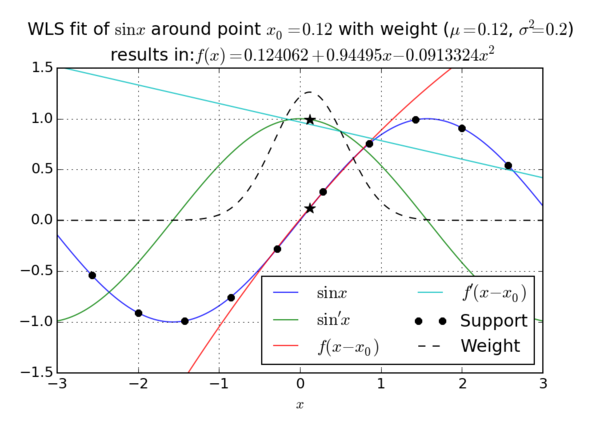Difference between revisions of "Weighted Least Squares (WLS)"
| Line 8: | Line 8: | ||
\[\hat u({\bf{p}}) = \sum\limits_i^m {{\alpha _i}{b_i}({\bf{p}})} = {{\bf{b}}^{\rm{T}}}{\bf{\alpha }}\] | \[\hat u({\bf{p}}) = \sum\limits_i^m {{\alpha _i}{b_i}({\bf{p}})} = {{\bf{b}}^{\rm{T}}}{\bf{\alpha }}\] | ||
where $\hat u,\,{B_i}\,and\,{\alpha _i}$ stand for approx. function, coefficients and basis function, respectively. We minimize the sum of residuum squares, i.e., the sum of squares of difference between the approx. function and target function, in addition we can also add weight function that controls the significance of nodes, i.e., | where $\hat u,\,{B_i}\,and\,{\alpha _i}$ stand for approx. function, coefficients and basis function, respectively. We minimize the sum of residuum squares, i.e., the sum of squares of difference between the approx. function and target function, in addition we can also add weight function that controls the significance of nodes, i.e., | ||
| + | [{_ <math display='block' xmlns='http://www.w3.org/1998/Math/MathML'> | ||
| + | <semantics> | ||
| + | <mrow> | ||
| + | <msup> | ||
| + | <mi>r</mi> | ||
| + | <mn>2</mn> | ||
| + | </msup> | ||
| + | <mo>=</mo><mstyle displaystyle='true'> | ||
| + | <munderover> | ||
| + | <mo>∑</mo> | ||
| + | <mi>j</mi> | ||
| + | <mi>n</mi> | ||
| + | </munderover> | ||
| + | <mrow> | ||
| + | <mi>W</mi><mrow><mo>(</mo> | ||
| + | <mrow> | ||
| + | <msub> | ||
| + | <mstyle mathvariant='bold' mathsize='normal'><mi>p</mi></mstyle> | ||
| + | <mi>j</mi> | ||
| + | </msub> | ||
| + | </mrow> | ||
| + | <mo>)</mo></mrow><msup> | ||
| + | <mrow> | ||
| + | <mrow><mo>(</mo> | ||
| + | <mrow> | ||
| + | <mi>u</mi><mo stretchy='false'>(</mo><msub> | ||
| + | <mstyle mathvariant='bold' mathsize='normal'><mi>p</mi></mstyle> | ||
| + | <mi>j</mi> | ||
| + | </msub> | ||
| + | <mo stretchy='false'>)</mo><mo>−</mo><mover accent='true'> | ||
| + | <mi>u</mi> | ||
| + | <mo>^</mo> | ||
| + | </mover> | ||
| + | <mo stretchy='false'>(</mo><msub> | ||
| + | <mstyle mathvariant='bold' mathsize='normal'><mi>p</mi></mstyle> | ||
| + | <mi>j</mi> | ||
| + | </msub> | ||
| + | <mo stretchy='false'>)</mo></mrow> | ||
| + | <mo>)</mo></mrow></mrow> | ||
| + | <mn>2</mn> | ||
| + | </msup> | ||
| + | </mrow> | ||
| + | </mstyle><mo>=</mo><msup> | ||
| + | <mrow> | ||
| + | <mrow><mo>(</mo> | ||
| + | <mrow> | ||
| + | <mstyle mathvariant='bold' mathsize='normal'><mi>B</mi><mi>α</mi></mstyle><mo>−</mo><mstyle mathvariant='bold' mathsize='normal'><mi>u</mi></mstyle></mrow> | ||
| + | <mo>)</mo></mrow></mrow> | ||
| + | <mtext>T</mtext> | ||
| + | </msup> | ||
| + | <mstyle mathvariant='bold' mathsize='normal'><mi>W</mi></mstyle><mrow><mo>(</mo> | ||
| + | <mrow> | ||
| + | <mstyle mathvariant='bold' mathsize='normal'><mi>B</mi><mi>α</mi></mstyle><mo>−</mo><mstyle mathvariant='bold' mathsize='normal'><mi>u</mi></mstyle></mrow> | ||
| + | <mo>)</mo></mrow></mrow> | ||
| + | <annotation encoding='MathType-MTEF'>MathType@MTEF@5@5@+= | ||
| + | feaagKart1ev2aaatCvAUfeBSjuyZL2yd9gzLbvyNv2CaerbuLwBLn | ||
| + | hiov2DGi1BTfMBaeXatLxBI9gBaerbd9wDYLwzYbItLDharqqtubsr | ||
| + | 4rNCHbGeaGqipu0Je9sqqrpepC0xbbL8F4rqqrFfpeea0xe9Lq=Jc9 | ||
| + | vqaqpepm0xbba9pwe9Q8fs0=yqaqpepae9pg0FirpepeKkFr0xfr=x | ||
| + | fr=xb9adbaqaaeGaciGaaiaabeqaamaabaabaaGcbaGaamOCamaaCa | ||
| + | aaleqabaGaaGOmaaaakiabg2da9maaqahabaGaam4vamaabmaabaGa | ||
| + | aCiCamaaBaaaleaacaWGQbaabeaaaOGaayjkaiaawMcaamaabmaaba | ||
| + | GaamyDaiaacIcacaWHWbWaaSbaaSqaaiaadQgaaeqaaOGaaiykaiab | ||
| + | gkHiTiqadwhagaqcaiaacIcacaWHWbWaaSbaaSqaaiaadQgaaeqaaO | ||
| + | GaaiykaaGaayjkaiaawMcaamaaCaaaleqabaGaaGOmaaaaaeaacaWG | ||
| + | QbaabaGaamOBaaqdcqGHris5aOGaeyypa0ZaaeWaaeaacaWHcbGaaC | ||
| + | ySdiabgkHiTiaahwhaaiaawIcacaGLPaaadaahaaWcbeqaaiaabsfa | ||
| + | aaGccaWHxbWaaeWaaeaacaWHcbGaaCySdiabgkHiTiaahwhaaiaawI | ||
| + | cacaGLPaaaaaa@5BA9@ | ||
| + | </annotation> | ||
| + | </semantics> | ||
| + | </math>}] | ||
Revision as of 17:22, 20 October 2016
One of the most important building blocks of the meshless methods is the Moving Least Squares approximation, which is implemented in the EngineMLS class.
In general, approximation function can be written as \[\hat u({\bf{p}}) = \sum\limits_i^m {{\alpha _i}{b_i}({\bf{p}})} = {{\bf{b}}^{\rm{T}}}{\bf{\alpha }}\] where $\hat u,\,{B_i}\,and\,{\alpha _i}$ stand for approx. function, coefficients and basis function, respectively. We minimize the sum of residuum squares, i.e., the sum of squares of difference between the approx. function and target function, in addition we can also add weight function that controls the significance of nodes, i.e., [{_ Failed to parse (Missing <code>texvc</code> executable. Please see math/README to configure.): {\displaystyle <semantics> <mrow> <msup> <mi>r</mi> <mn>2</mn> </msup> <mo>=</mo><mstyle displaystyle='true'> <munderover> <mo>∑</mo> <mi>j</mi> <mi>n</mi> </munderover> <mrow> <mi>W</mi><mrow><mo>(</mo> <mrow> <msub> <mstyle mathvariant='bold' mathsize='normal'><mi>p</mi></mstyle> <mi>j</mi> </msub> </mrow> <mo>)</mo></mrow><msup> <mrow> <mrow><mo>(</mo> <mrow> <mi>u</mi><mo stretchy='false'>(</mo><msub> <mstyle mathvariant='bold' mathsize='normal'><mi>p</mi></mstyle> <mi>j</mi> </msub> <mo stretchy='false'>)</mo><mo>−</mo><mover accent='true'> <mi>u</mi> <mo>^</mo> </mover> <mo stretchy='false'>(</mo><msub> <mstyle mathvariant='bold' mathsize='normal'><mi>p</mi></mstyle> <mi>j</mi> </msub> <mo stretchy='false'>)</mo></mrow> <mo>)</mo></mrow></mrow> <mn>2</mn> </msup> </mrow> </mstyle><mo>=</mo><msup> <mrow> <mrow><mo>(</mo> <mrow> <mstyle mathvariant='bold' mathsize='normal'><mi>B</mi><mi>α</mi></mstyle><mo>−</mo><mstyle mathvariant='bold' mathsize='normal'><mi>u</mi></mstyle></mrow> <mo>)</mo></mrow></mrow> <mtext>T</mtext> </msup> <mstyle mathvariant='bold' mathsize='normal'><mi>W</mi></mstyle><mrow><mo>(</mo> <mrow> <mstyle mathvariant='bold' mathsize='normal'><mi>B</mi><mi>α</mi></mstyle><mo>−</mo><mstyle mathvariant='bold' mathsize='normal'><mi>u</mi></mstyle></mrow> <mo>)</mo></mrow></mrow> <annotation encoding='MathType-MTEF'>MathType@MTEF@5@5@+= feaagKart1ev2aaatCvAUfeBSjuyZL2yd9gzLbvyNv2CaerbuLwBLn hiov2DGi1BTfMBaeXatLxBI9gBaerbd9wDYLwzYbItLDharqqtubsr 4rNCHbGeaGqipu0Je9sqqrpepC0xbbL8F4rqqrFfpeea0xe9Lq=Jc9 vqaqpepm0xbba9pwe9Q8fs0=yqaqpepae9pg0FirpepeKkFr0xfr=x fr=xb9adbaqaaeGaciGaaiaabeqaamaabaabaaGcbaGaamOCamaaCa aaleqabaGaaGOmaaaakiabg2da9maaqahabaGaam4vamaabmaabaGa aCiCamaaBaaaleaacaWGQbaabeaaaOGaayjkaiaawMcaamaabmaaba GaamyDaiaacIcacaWHWbWaaSbaaSqaaiaadQgaaeqaaOGaaiykaiab gkHiTiqadwhagaqcaiaacIcacaWHWbWaaSbaaSqaaiaadQgaaeqaaO GaaiykaaGaayjkaiaawMcaamaaCaaaleqabaGaaGOmaaaaaeaacaWG QbaabaGaamOBaaqdcqGHris5aOGaeyypa0ZaaeWaaeaacaWHcbGaaC ySdiabgkHiTiaahwhaaiaawIcacaGLPaaadaahaaWcbeqaaiaabsfa aaGccaWHxbWaaeWaaeaacaWHcbGaaCySdiabgkHiTiaahwhaaiaawI cacaGLPaaaaaa@5BA9@ </annotation> </semantics> } }]
